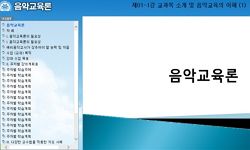Music Aesthetic Education is important to provide the opportunity to experience the aesthetic experience to the aesthetic sense and empathy that comes from representation. Students will determine the aesthetic quality in a number of ways to experience...
http://chineseinput.net/에서 pinyin(병음)방식으로 중국어를 변환할 수 있습니다.
변환된 중국어를 복사하여 사용하시면 됩니다.
- 中文 을 입력하시려면 zhongwen을 입력하시고 space를누르시면됩니다.
- 北京 을 입력하시려면 beijing을 입력하시고 space를 누르시면 됩니다.
중학교 음악 수업에 있어서 심미적 음악 예술의 지도방법 연구 = In the middle school music teaching methods of music art aesthetic research map
한글로보기https://www.riss.kr/link?id=T13700575
- 저자
-
발행사항
경산 : 대구가톨릭대학교 교육대학원, 2015
-
학위논문사항
학위논문(석사) -- 대구가톨릭대학교 교육대학원 , 음악교육전공 음악교육 , 2015. 2
-
발행연도
2015
-
작성언어
한국어
- 주제어
-
발행국(도시)
경상북도
-
형태사항
iv, 74 p. ; 26 cm
-
일반주기명
지도교수: 김회영
- 소장기관
-
0
상세조회 -
0
다운로드
부가정보
다국어 초록 (Multilingual Abstract)
Music Aesthetic Education is important to provide the opportunity to experience the aesthetic experience to the aesthetic sense and empathy that comes from representation.
Students will determine the aesthetic quality in a number of ways to experience music and to seek the meaning associated with each of the musical life.
Therefore, the teacher valuable artistic music, a variety of music, presenting students and students interested in music and to have their own 'ability to feel' deep interest in instilling the ‘aesthetic attitude’ with an emphasis on art in the life that they should that.
Music means of aesthetic experience is an aesthetic perception takes place through music experiences and the interaction of aesthetic response.
Will explore the expressive qualities that are inherent in the work and the meaning and By discovering the beauty that was created by the artist when viewed in terms of educational and artistic beauty perfume expresses the meaning of music learners.
These experiences are ultimately gives sensitive perception of the beauty of the music and aesthetic sensitivity reactions evolved.
This study B. Reimer music education methods based on teaching methods in order to create an appreciation for music aesthetic experience to learn what the aesthetic experience of music tracks, depending on the music selection criteria applied to music aesthetic act of B. Reimer was to create an example of appreciation classes for aesthetic experience.
Firstly, that music selection criteria B. Reimer selected by default when music was considered the educational usefulness.
Plan a variety of learning resources in order to increase the understanding and interest in art song was able to increase the interest in art songs through the use of various musical components to students by presenting the Plan.
Second, if the accompaniment and rhythm to express how the content of the poem is written in the score and musical beauty and artistic insight into the meaning and experience of musical acts through even feel the flow of the rhythm and music can express creatively, that while listening to music Imagine the feelings of the characters are seen in the poetry of Goethe, more aesthetic perception will be able to concentrate.
The teaching method is based on the absolute expressionist aesthetic theory of B. Reimer, never expressionism has been teaching approach based on the implementation of the feeling type that art.
Third, Configure the lesson plans for students continually motivated to help you remember the rhythm until the end of the first half in the intro music using that directly improves motivation when participating in class and feeling alive when the contents of the is based on the ultimate goal of the cast of the musical aesthetic that could deepen the aesthetic experience to be able to develop their individual aesthetic sensibility as much as possible, by singing the lyrics education.
As a result, when you configure a music class B. Reimer's musical aesthetic behavior because that theory is applied to the music lesson plans teaching students to plan a variety of questions and study materials to explore their own musical elements and principles and concepts students to explore themselves and to induce a positive answer to lead an active class participation will reach the goal of aesthetic music education.
When you see these findings B. Reimer enjoy the art of music lessons apply the aesthetic experience is based on the teaching of music to students of beauty and aesthetic sensitivity to stimulation due to the execution of an aesthetic act is the development of aesthetic sensibility aesthetic education will enable that.
목차 (Table of Contents)
- Ⅰ.서론 1
- 1. 연구의 목적과 필요성 1
- 2. 연구의 범위 및 방법 3
- Ⅱ. 음악 예술의 교육철학 4
- Ⅰ.서론 1
- 1. 연구의 목적과 필요성 1
- 2. 연구의 범위 및 방법 3
- Ⅱ. 음악 예술의 교육철학 4
- 1. 음악교육철학의 중요성 4
- 2. 음악교육의 개념 및 목적 6
- Ⅲ. 20세기 교육철학자들의 사상과 교수법 11
- 1. 리머의 음악교육 철학과 교수법 11
- 2. 엘리엇의 음악교육 철학과 교수법 25
- Ⅳ. 리머의 음악교육 교수법을 적용한 음악수업 지도안 32
- 1. 리머가 제시하는 음악교육과정 32
- 2. 2009년 개정 음악과 교육과정 36
- 3. 리머의 감상수업 지도방안 42
- 4. 리머의 음악교육 교수법을 적용한 감상수업 지도안 작성 45
- Ⅴ. 결론 68
- 참고문헌 73








